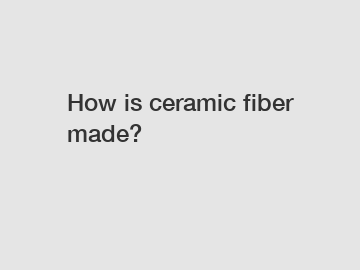How is ceramic fiber made?
How is ceramic fiber made? - Unveiling the Mystery Behind This Remarkable Material .
Ceramic fiber is a fascinating material that finds wide-ranging applications in various industries. From insulation in high-temperature environments to reinforcing materials in composites, ceramic fiber offers exceptional thermal stability, low thermal conductivity, and excellent resistance to chemical attacks. But have you ever wondered how this remarkable material is made? In this article, we will delve into the intricate process of manufacturing ceramic fiber, shedding light on its origins, composition, and manufacturing techniques. So, let's embark on an enlightening journey to explore the secrets behind the creation of ceramic fiber.
1. Understanding the Basics:

Ceramic fiber is a type of refractory material composed primarily of alumina and silica. These raw materials are carefully selected and mixed to form a slurry or paste consistency, which is then used as the starting point for the production of ceramic fiber. .
2. The Spinning Process:
Once the slurry is ready, it is subjected to a spinning process. In this stage, the slurry is forced through spinnerets, which are small holes in a metal plate, to create very fine and continuous fibers. The spinnerets are designed to control the diameter of the fibers, ensuring uniformity and consistency.
3. Precursor Firing:
After the spinning process, the fibers are still not fully ceramic. They are referred to as precursors, which means they contain organic binders and additives. To remove these organic components, the precursors are first subjected to a heating and drying process, known as precursor firing. This step helps eliminate any impurities and ensures a clean, pure ceramic fiber product.
4. Sintering and High-Temperature Treatment:
Next, the precursor fibers undergo sintering, a process that involves heating the fibers to a high temperature. Sintering fuses the ceramic particles together, enhancing the mechanical strength and stability of the fibers. High-temperature treatment further refines the fiber structure, removing any residual organic matter and transforming the precursors into fully ceramic fibers. .
5. Post-Treatment:
After the sintering and high-temperature treatment, the ceramic fibers are usually treated with a special coating. This coating helps improve their thermal stability, making them even more resistant to heat and thermal shocks. It also helps to reduce the fiber's tendency to release dust particles, making it safer to handle during installation or other processes.
6. Cutting and Packaging:
Once the fibers have been treated and coated, they are ready to be processed into various forms, such as blanket, board, module, or paper, depending on their intended use. Different cutting and packaging methods are employed to create these diverse forms, ensuring that the ceramic fiber is readily usable for specific applications.
7. Safety Measures:
It is important to note that the manufacturing of ceramic fiber involves high-temperature processes, making safety a top priority. Adequate ventilation, proper personal protective equipment, and adherence to safety guidelines are critical during all stages of production. Manufacturers also ensure the continuous monitoring of air quality to minimize any potential health hazards associated with the production process.
In conclusion, ceramic fiber is a remarkable material that offers exceptional thermal properties and resistance to harsh conditions. The manufacturing process behind ceramic fiber involves several critical stages, including the initial slurry formulation, spinning, precursor firing, sintering, high-temperature treatment, post-treatment, and finally cutting and packaging. Each step contributes to the creation of a high-quality, durable ceramic fiber product with outstanding performance capabilities.
Understanding how ceramic fiber is made not only enriches our knowledge but also highlights the complexity and precision involved in its production. As industries continue to rely on ceramic fiber for insulation, fire protection, and other applications, it is important to appreciate the intricate craftsmanship required to ensure its reliable performance. Whether used to insulate furnaces, provide thermal protection in aerospace applications, or enhance the strength of composite materials, ceramic fiber remains a vital component in various industries, pushing the boundaries of what is possible with advanced materials.
The company is the world’s best ceramic fibre blanket dealer, magnesia spinel bricks manufacturer, high alumina bricks supplier. We are your one-stop shop for all needs. Our staff are highly-specialized and will help you find the product you need.


